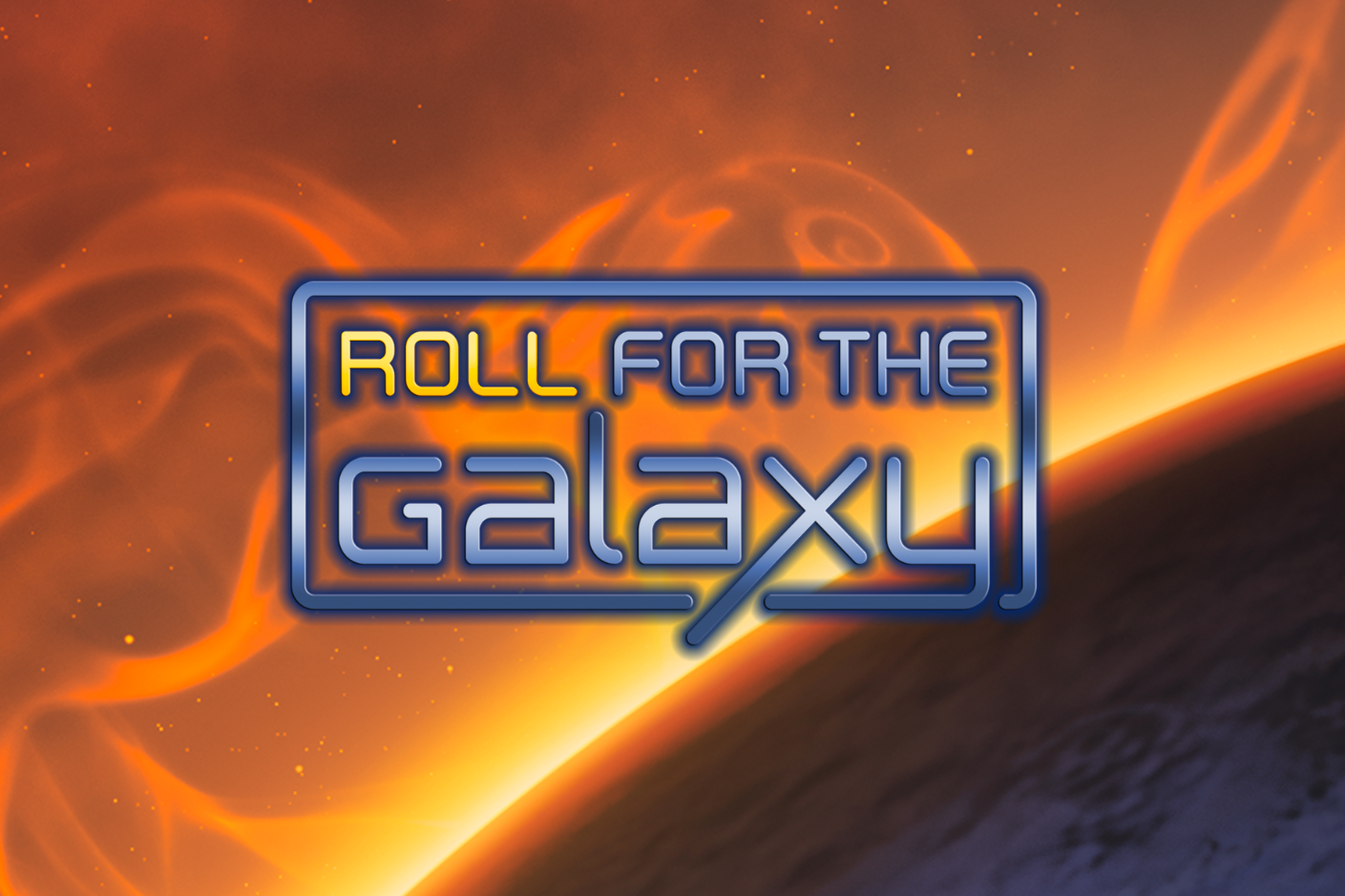Who doesn’t love a little galactic conquest? Throwing caution to the wind and throwing dice on the table. Setting up the perfect path to victory, watching it derail it into a disaster, and then turning bitter defeat into sweet victory. That’s luck for you, that’s planning and strategy. That’s Roll for the Galaxy.
Disclaimer: The apps in this review were provided to Goonhammer.com by Temple Gates Games.
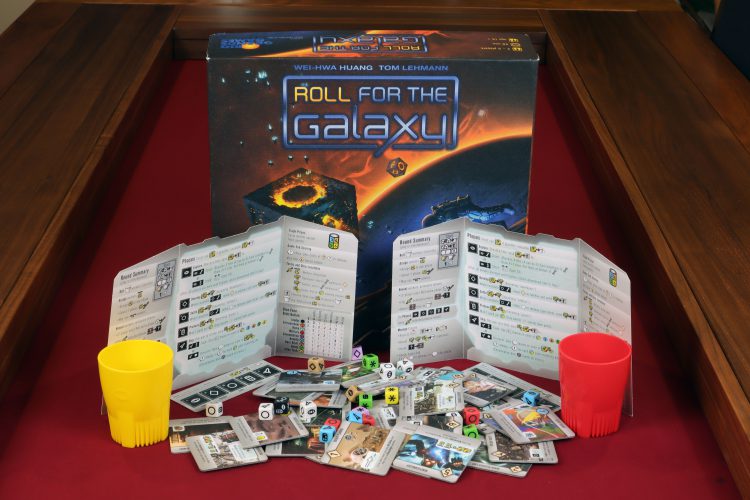
Roll for the Galaxy is a competitive dice-rolling, tableau-building game of galactic conquest for two to five players. You grow your empire one planet at a time, developing technologies that let you bend and break the rules, and amassing Victory Points in a race to see which player comes out on top and controls the fate of the galaxy. If you are familiar with Race for the Galaxy, then you’ll feel right at home. Roll is reimplementation of Race, but Roll for the Galaxy uses dice and two-sided tiles instead of Race’s cards and, well, more cards. If you aren’t familiar with Race for the Galaxy, then check out our review of it right here. Spoilers: I think highly of it.
Before we get into the nitty gritty of how the game works, let’s first go over how you can play it. It was initially released as a physical board board back in 2014 followed shortly after by the Ambition expansion, and followed again in 2019 with the Rivalry expansion. The digital version was released in August 2020 for iOS, Android, and PC. None of the expansions are out yet for the apps, but I bet they’re on their way.
How Do I Turn Dice into Conquest?
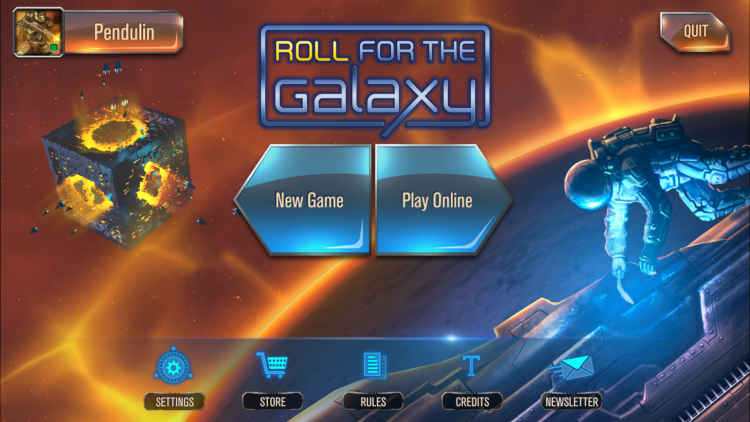
Roll for the Galaxy is easier to learn if you are already familiar with it’s older brother, Race for the Galaxy. They share many mechanics, iconography, and even most of the art assets. However, there are enough differences that even Race veterans will need to crack the rulebook to learn Roll. Fortunately, the app has an in-game tutorial, rulebook, as well a link to the rulebook PDF, so the digital version gives you all the resources you need to learn how to play. Rather than rehashing all the rules, I’ll go over the basics so you can get a feel for the game.
The game revolves around dice. Rolling them is even right in the title. But these aren’t your parents dice with pips or numbers. No, these are dice with symbols that correspond with the different phases of the game: Explore, Settle, Develop, Produce, and Ship. At the start of each turn you roll all the dice in your cup, and whichever phase they land on is the phase in which they can be used. Roll three settlers and two developers? That means you have three dice that can be used to settle new worlds in your empire, and two to help develop new technologies.
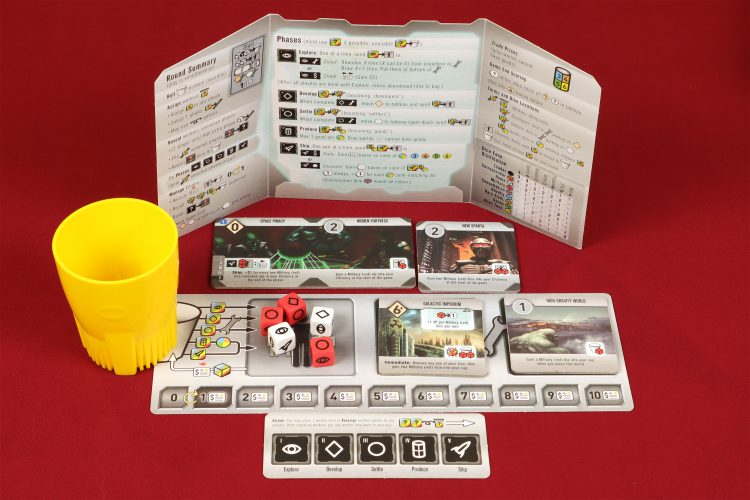
The math-astute among you may notice that there are five phases to the game and there are six sides on these dice, so what’s the deal? And what about these prismatic dice of many colors? Do those colors mean anything? Which color is best and why is it yellow?
Here’s one the games more clever mechanics: the dice’s color let you know which phases are on it. White dice (called Home Dice) have all five phases and two faces with the Explore symbol. All players start with some of these, meaning by sheer odds that there is going to be a lot of exploration during the early game. Red dice (Military), on the other hand, only have a single Explore but have two Develop, two Settle, zero Ship, and they also have a wild face! That wild face can be used during any phase, which makes the military dice your best option for settling worlds and developing technology. Yellow dice (Alien), are missing Explore and Ship, but have three fantastically useful wilds. Due to how powerful they are, you’re unlikely to see a lot of them during the game, and they tend to take a lot of resources to acquire, but they pay for themselves in sheer utility.
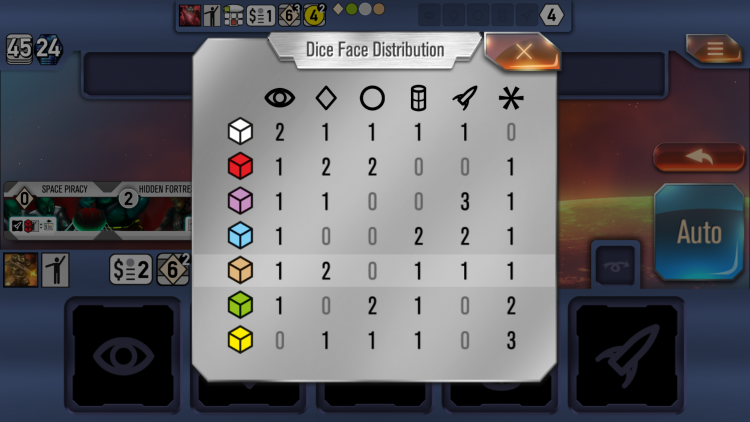
Each of the seven colors of dice have a different combination of phases, and it’s up to you to figure out which ones will work best with your strategy. Trying to settle many small worlds to sneak a victory before your opponent can get their engine running? Military would be a good option, so keep an eye out for worlds and technologies that give you red dice. Vying for a trade victory? Blue (Novelty) and purple (Consumption) dice will have you raking in the victory points.
The expansions add additional colors of dice with powerful effects, as well as a build-your-own-dice mechanic that has you physically modifying the faces of dice with snap-in pieces. Very cool stuff.
But dice alone won’t conquer the galaxy. You need worlds to settle, you need technologies to develop. That’s where the game’s other primary component comes in: the tiles.
We Can’t Stop Here, This is Tile Country
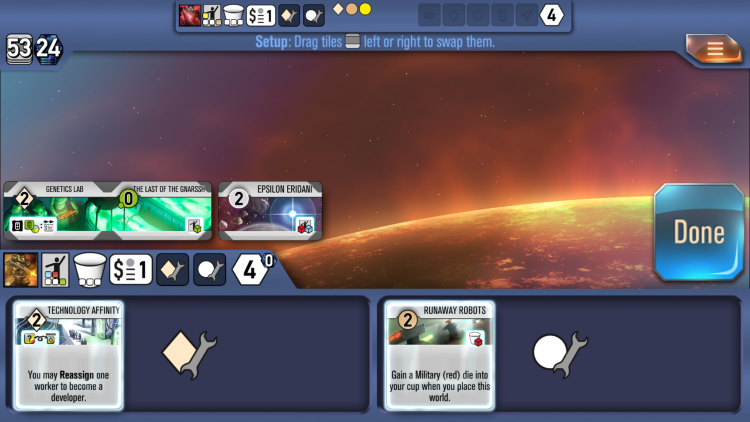
Other than dice, the other piece to this galactic puzzle are the two-sided tiles: one side with a technology you can develop, and the other side a world you can settle. You acquire new tiles in the Explore phase, and each dice you use during the Explore phase lets you draw one tile and pick which side you prefer. However, you don’t get the benefits to that side right away. You first need to settle worlds for to earn their reward of (usually) more dice, and you need to develop technologies to get their benefit of (typically) bending the rules on how you play. You add these completed tiles to your tableau to indicate they are completed. Keep an eye on your opponent’s tableau though, as you’ll be able to see what benefits they are receiving from their developments, how many victory points they have, and how close the game is to ending. For when any player’s tableau reaches 12 tiles, the game ends at the end of that round.
All players start the game with three random tiles already completed in their tableau: 1 home world tile that functions like a regular world, and 1 faction tile that is twice as wide, counts as two tiles, and gives you a unique ability that other players won’t have. Additionally, each player starts with two random tiles which are pre-explored and ready to be settled or developed
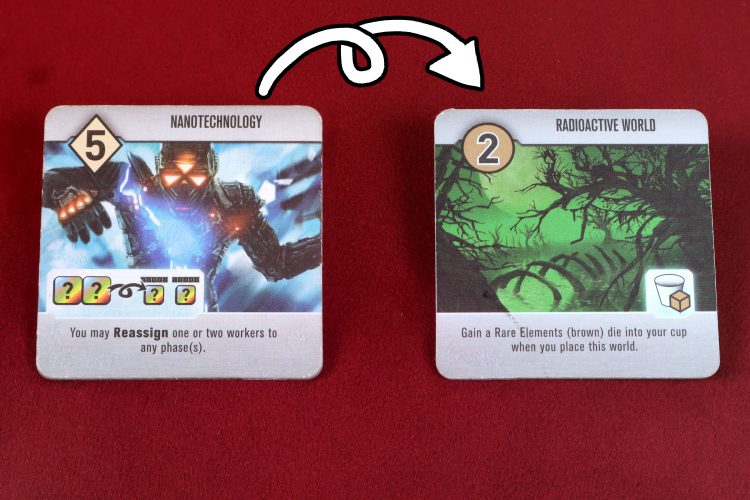
Each tile has a big number on either side, and that number represents two separate things: how many sweet, sweet victory points it’s worth, and also how many resources it takes to develop or settle. If a world has a giant “3” on it, then that means it requires you to spend 3 dice showing the Settle phase to add it to your tableau, and once you do that it’s worth 3 victory points at the end of the game. But thinking back on how the dice work, you might wonder what are the odds you’ll get 3 Settles on your dice, when your Home dice only have a single face with the Settle symbol. That’s where developments come into play. Developments grant powerful abilities that change the rules. One might let you treat a single dice that landed on Explore as if it instead was a wild. Another might let you pretend you rolled two bonus extra Ship’s each turn. They might even let you draw extra tiles during the Explore phase, lower the cost of developments, or refund the cost of newly settled worlds.
Some developments even have a listed cost of “6+”, which means they cost 6 dice to develop but have the potential for granting more than 6 victory points. One such development gives you a bonus victory points based on the total cost of developments in your tableau, and lets you place two dice used to complete future developments right back into your cup, basically refunding the cost. You can base an entire game-plan around maximizing the victory points awarded by a single 6+ development. They can be that powerful.
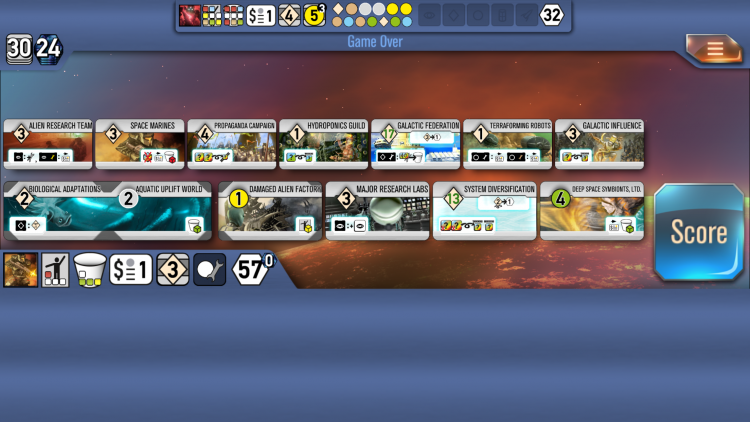
If Roll for the Galaxy was a car and dice were it’s gasoline, then worlds would be the frame holding it together, and developments would be Tommy Lee Jones asking you to “push the little red button.”
It’s Not a Phase, Mom. It’s Five Phases
The last piece of information you need to really get a feel for all the moving parts of this game is Phase Selection. Each turn you take one of the dice you rolled and use it to select one of the five phases: Explore, Develop, Settle, Produce, or Ship. You do this in secret, and all players simultaneously reveal their selections. If a phase wasn’t selected by any player, then that phase is skipped for this round. Any dice you had for that phase go right back into your cup where they will wait for the following round.
When playing with only two player rules, when revealing your selected phase, a single white (Home) dice is rolled to the side. Whichever phase that lands on is also played this round.

Another clever mechanic of this game is that you may pick any phase with any dice – the symbols don’t have to match. If you are going for a world-settlement victory and happen to roll a useless Ship, then you can use that dice to select the Settle phase and treat it as if it had rolled a Settle symbol. This gives you some control over the randomness of the game without waiting for developments.
Additionally, you can burn a single dice each turn to reassign any other single dice to any phase. The name for this action is dictate, which I’ve always found to be a strange term for it. But strange name or not, it’s a crucial tool available to help make the best of bad rolls. And even though it costs you a dice to dictate, it’s usually worth it because that dice goes right back into your cup, so it’s back in action next round.
With all this said, you should start to have a picture in your head of what it’s like to play Roll for the Galaxy. It’s a game about planning your next several turns, about making the best of bad rolls, playing the odds, gambling on a long shot, and celebrating when you get that perfect roll. But how close are you to knowing all the rules? Well, still a ways off, unfortunately.
Roll’s Rich Rules
Roll for the Galaxy has a lot of rules. We’re about 1,500 words in, and I haven’t even brought up how currency works, or the difference between dice in your cup or your citizenry. We haven’t looked at the Produce-Ship cycle nor the difference between consuming and trading while shipping. We haven’t gone over discarding tiles or the construction zone stack. Even if you get all of this down, each sides of every tile has a sentence or two containing the rules for it’s particular effects. While the rulebook is a mere 12 pages, they are dense with information you need to know. If you are playing on the app, you’ll fortunately have access to aforementioned in-app rules, tutorial, and rule PDF. But even still, there’s a lot to keep in your head when playing.
The physical version of the game has you rolling and assigning dice behind a small screen to keep it secret from other players. Fortunately, that screen is also a reference sheet containing all the common rules, so you’ll have the rules right in front of you at all times.
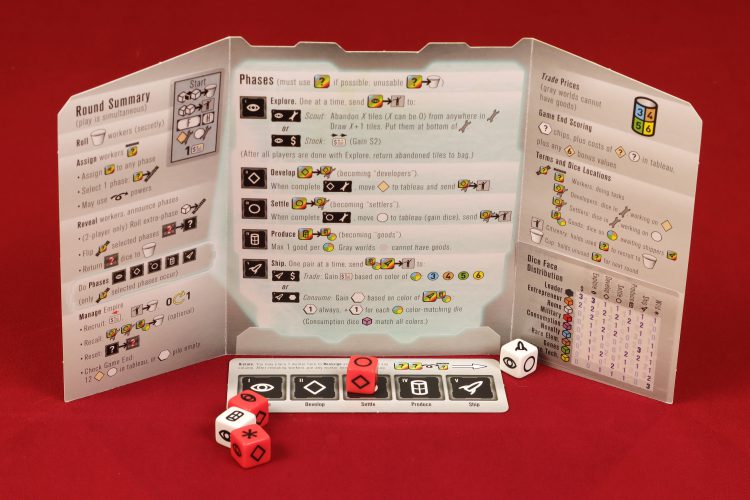
However, the density of all these rules is not necessarily a bad thing. I’m a big fan of this quote from from Antoine de Saint-Exupéry: “Perfection is attained not when there is nothing more to add, but when there is nothing more to remove.” While I don’t believe this game is perfection, and there are some rules that could do with some cleanup, I do believe that there are very few mechanics that could be removed without changing the fundamental game. There are a lot of moving pieces, but they work together to create a game that you can play a hundred times and still see new and interesting tactics.
An App, An App, My Money for an App
Gameplay aside, how well does the digital version perform as an app? Quite well, I was surprised to find out. Much of this game relies on dice as physical objects. They represent both the randomness in the game, as well as actual tokens you move around. I was worried that this would translate into a clunky experience, but it’s actually rather nice. Dragging dice around is fast and easy, and many phases of the game take advantage of an “Auto” button that you can press to perform tasks that would be otherwise tedious in an app. For example, instead of physically moving dice to a world to settle it, then moving the dice back to your citizenry once they are used, then moving the world to your tableau, you just slam the Auto button and everything is taken care of.
I’ve noticed a few small bugs in my time with the app: there is a graphical bug on iOS when you press and drag a tile between the settle and development slots causing the screen to flash for a moment, and sometimes the tooltips for the Trade phase get out of sync when you start throwing a ton of dice around. I haven’t experienced either of those in the desktop app, and unfortunately I haven’t tried the Android app but I would be willing to bet it is comparable to the iOS version. And aside from those bugs, it’s been an extremely smooth experience in my 75 games played. A far cry from the 3,500 games I’ve played in Race for the Galaxy’s app, but I’m getting there.
The desktop app was a little jarring at first, but that’s because it’s basically the iOS/Android app, blown up to your whole monitor. The UI elements look great on a handheld device, but when stretched out to a full-screen computer monitor, things are strangely proportioned. Do yourself a favor and turn off fullscreen and set the text to “Jumbo”. Actually, set the text to Jumbo on iOS and Android as well. You’ll miss out on seeing some of the art, which is unfortunate, but the text on the tiles will be more more legible.

The app’s multiplayer comes in two varieties: pass-and-play and online matchmaking. Of the two, pass-and-play is a much more enjoyable experience because the online mode suffers from the same sorts of issues that many asynchronous multiplayer games have. You do your thing, and then have to wait for each other player to do theirs. If they happen to put their phone down or walk away, you might be waiting on them for hours or days for them to take their turn. If you want to play with a friend on Steam, however, you are forced to use Steam’s remote play feature and the pass-and-play mode. It works, but it’s really weird and clunky.
That being said, I don’t actually mind any of the weirdness of multiplayer. This is the type of game I enjoy solo. Crank the AI up to as difficult as it can get, and try to figure out how to beat it. The AI is ruthlessly smart and can be set to one of three difficulties: Easy AI, Medium AI, or You Are Going To Lose Until You Get Really Good AI. On it’s hardest setting, every turn is a puzzle. Do I place this dice in Settle but select the Trade phase hoping that the AI will select the Settle phase? Do I throw this crummy development into the woodchipper in hopes of getting something better, or do I take the option for cold hard cash instead? Do I rush endgame to prevent them from finishing that big 6+ development, or do I try to counter it with my own 6+ development? Did I forget to eat dinner today because I was binge playing Roll for the Galaxy?
Final Thoughts; or, How I Learned to Stop Worrying and Love the Galaxy

But how does the game stack up to it’s older, card-based brother Race for the Galaxy? Well, my opinion is a bit mixed. Race is definitely more competitive, as there are few fewer random elements than in Roll. Race is also more streamlined and faster to play. For example, I once tried to play an entire game of Race for the Galaxy while holding my breathe. It didn’t work at all, but that I thought it might shows how much faster Race is. The rules for Race are also much simpler, to the point where most cards don’t even have text on them, just iconography to remind you how things work. If you are looking for a competitive card-based game that plays fantastically in an single-player app, then I’d pick Race for the Galaxy.
However, sometimes you aren’t in the mood for a competitive game. Sometimes you just want to hang out with a friend and throw some dice. That’s where Roll for the Galaxy shines. The randomness is an equilizer that lets new players have a chance at beating experienced players. Having some rules written in English right on the tiles themselves mean you don’t have to rely on the iconography and memorizing a bunch of symbols. Grabbing a cup of dice, shaking them around, and slamming them on a table just plain feels good. There’s that brief moment after you roll the dice but before you see the results, it’s like opening a Christmas present that’ll either be coal or candy. Unfortunately, a lot of that is lost in the app, but it’s all there in the physical board game. If you’re looking for a fun, relaxing game for you and some friends which let’s you chat for a while, pop over to the kitchen and grab glass of water and a handful of chips, and come back to the game without missing a beat, then I’d pick Roll for the Galaxy. And if you’re a fan of it, give the app a chance too, as it’s good fun.
Or, get both of them. Get both the app and physical versions of Race for the Galaxy and Roll for the Galaxy. I certainly did.
